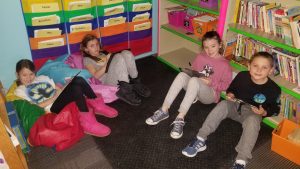Mindful Awareness Practices (MAPs)
Practicing mindfulness helps us to reset, refocus and energize for what's ahead! Learn more about Mindful Awareness Practices (MAPs) and how to practice them at school or at home.
Read More Being able to calm yourself when emotions run high – or self-regulate – is a learned skill. Similar to how a child is taught to tie their shoe once they have the fine motor skills to do so, once a child’s brain is developmentally ready to self-regulate, they can learn different strategies and ways that work well for them. Think about what worked well for you the last time you felt angry, unheard, anxious or any other negative feeling. Did you go outside to get fresh air? Did you practice yoga or meditation? Take 10 deep breaths? Go to your favorite room in your home and read? We all have different coping mechanisms we’ve learned to use to regulate our emotions and return to a more neutral or positive space. Kids are no different!
Being able to calm yourself when emotions run high – or self-regulate – is a learned skill. Similar to how a child is taught to tie their shoe once they have the fine motor skills to do so, once a child’s brain is developmentally ready to self-regulate, they can learn different strategies and ways that work well for them. Think about what worked well for you the last time you felt angry, unheard, anxious or any other negative feeling. Did you go outside to get fresh air? Did you practice yoga or meditation? Take 10 deep breaths? Go to your favorite room in your home and read? We all have different coping mechanisms we’ve learned to use to regulate our emotions and return to a more neutral or positive space. Kids are no different!
One way to help children learn how to self-regulate is by providing them with calm down corners. A calm down corner is a designated space in a home or classroom with the sole intent of being a safe space for a child to go to when they feel their emotions are running too high and they need to regain their emotional and physical control. These spaces are equipped with comforting objects and soothing materials that can promote mindfulness, breathing and reflection.
The overall goal of a calm down corner is to provide the child with a space in which they’ll feel safe recognizing and regulating their emotions in a healthy way. These corners don’t need to be complicated and don’t even require purchasing any new materials or items if you do not want to. Calm down corners can be developed and promoted in a variety of ways and in both home and school settings.
Activities such as these help children explore…
Self-Awareness and Self-Management: Calm down corners help children to practice identifying feelings and emotions to better manage stress, self-regulate and control their impulses. Having a space designed to support them emotionally and physically helps them feel safe and comfortable, allowing them to let down their guard to process different feelings.
Relationship Skills: Learning how to communicate one’s feelings and emotions can be difficult, but calming spaces such as this help children practice mindfulness and develop skills they need to identify their emotions and communicate them when necessary. Stronger communication skills help them form stronger relationships with others and develop skills in empathy.
Some children find calming music to be helpful in regaining control of their emotions. In classroom settings, try having headphones available so the music doesn’t interrupt other students.
Add artwork to your space – some ideas that may work well for your children or students include nature and landscapes, or happy family photos.
Try out a basket with sensory play objects. For many kids, using and exploring sensory play can help them deescalate when they’re feeling overstimulated. Check out our Game On activity all about sensory play for more details.
For calm down corners in the classroom, make sure the space is inclusive and accessible to all your students. Although there may be students that need or want to utilize the space more than others, it’s important that all students know they’re welcome to use it, as well.
Don’t think of it as a “time out” or punishment – there shouldn’t be any stigma associated with the calm down corner. Although you may encourage a child to spend some time in the space when you feel they’re starting to become distressed, the goal is that eventually the child will recognize when they want to be there and will go there on their own in order to self-regulate and calm down.
For more activities and ideas like this one, be sure to sign up for our news and updates. And if you like what you see, please donate to support our work creating more ways to help build a healthier future for kids.
Categories: Social-Emotional Health, At Home, At School, Digital Resource